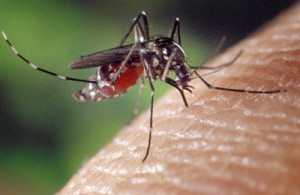My family and I just returned from a week-long camping trip along the North Shore of Lake Superior in Minnesota. It is beautiful country, filled with lakes, rivers, ponds—and mosquitoes, lots and lots of mosquitoes. We went prepared for the worse. We had a screen tent, head nets and tubes and tubes of insect repellent because in this area of the world, mosquitoes are a flying, buzzing, picnic-ruining, itch-inducing pest. In the US, though, a pest is really all they are. In other areas of the world they are a flying, buzzing, disease-carrying, deadly menace.

Mosquitos act as vectors for many diseases including malaria, Dengue fever, Yellow fever, encephalitis, West Nile Virus and chikungunya virus. Many of these diseases are deadly; in fact, mosquitoes are responsible for more human deaths than any other animal (~725,000 deaths annually). Although most of these diseases have a long and infamous history, two of them, West Nile virus (first identified in 1932) and chikungunya virus (first identified in 1950), are relative new comers on the world health stage.
In July, the US Centers for Disease Control and Prevention (CDC) announced the first case of chikungunya virus that appears to have been spread by a mosquito to someone who had not traveled to a known infected area. Although it is rarely fatal, the chikungunya virus does cause sever joint pain. It has also spread aggressively in the Northern Hemisphere since it first appeared in 2013, with more than 570,000 suspected cases reported in the Americas so far this year.
This month, the National Institute of Allergy and Infectious Disease (NIAID; a part of the Nation Institutes of Health) announced that an experimental vaccine for the chikungunya Virus had successfully completed its phase I clinical trial. The vaccine produced antibodies in all the volunteers who were injected, and the antibodies persisted in all the volunteers for at least 11 months. This was a small phase I study (25 volunteers), but the results are promising.
What was almost as interesting to me was what kind of vaccine this chikungunya vaccine was. Traditional vaccines use either killed viruses or weakened live viruses. The chikungunya vaccine was made using virus-like particles. This type of vaccine contains the outer shell proteins of a virus but not any of the material that a virus needs to replicate inside cells. No live virus is used in the production of these type of vaccines, eliminating the need for high-level bio containment conditions for manufacturing facilities.
As for my family’s camping trip, it turned out that all our preparedness was for naught. Unseasonably cold weather and dry conditions meant that the mosquito population was pretty low along the North Shore. If the chikungunya virus continues to spread though, we might be glad we have all those supplies for future camping trips, or at least until a vaccine such as the one the NIAID is developing has been approved.
Kelly Grooms
Latest posts by Kelly Grooms (see all)
- Avoid the Summertime Blue-Greens— Know about Cyanobacteria Before You Hit the Water - July 8, 2025
- Growing Our Understanding of Triple-Negative Breast Cancer in Sub-Saharan Africa: Why Comprehensive Population Data Matters - June 5, 2025
- Measles and Immunosuppression—When Getting Well Means You Can Still Get Sick - April 17, 2025
